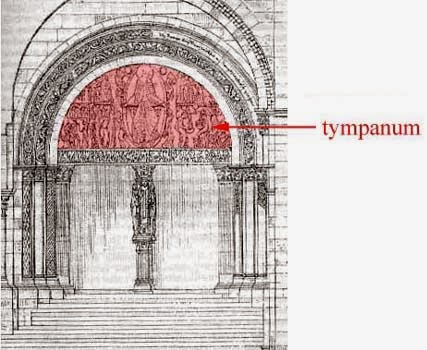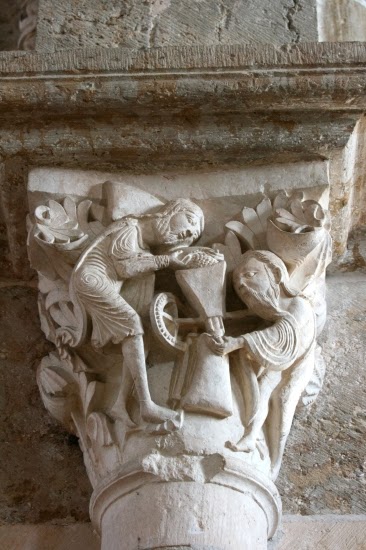Introduction to the Romanesque
The Romanesque
period was the first major art and architecture movement in Europe following
the ‘Dark Ages’.
The word
‘Romanesque’ was a 19th century term historians created to describe the style
of the period, forever linking it to the ancient Roman aesthetic and
roman basilicas.
The up-surging
power and dominance of the Roman Catholic Church.
Importance of pilgrimage routes – the enormous surge in building was due mainly to the
need for churches along the main pilgrimage routes to Santiago de Compostela.
The dreaded year 1000!
Romanesque Churches
Ancient Roman Basilica’s served as the architectural blueprint on which
Romanesque Churches developed.
The Basilica was
the beating heart of the ancient roman community. The Early Christian’s wanted
to replicate both its architectural format and its social importance.
Cluny Abbey, France is regarded as the first ‘Romanesque’ church
to be built.
It was the
largest church ever built and remained so until the 17th Century.
Romanesque architectural features
•Rounded Arches
– used on doors windows and as ornamental arcades on walls.
•Stone Roofs –
technical innovations included stone vaulting – it insulated against fire and
greatly improved acoustics.
•Excessively wide walls – to
carry the weight of the stone roofs.
•Cruciform
Shape – Sainte Lazare in Autun, France
•Small Narrow Windows – as
large windows would have weakened the walls – this resulted in dark interiors.
•Rounded Interior
Pillars
•Radiating
Chapels - St. Mary Magdelene in Vézelay
•Barrel & Groin
Vaulting
•Barrel vaulting was the first method tried, but the heavy stones
pressed out as well as down, causing the semi-circular arches to flatten, the
walls to push outwards and the roof to collapse. This problem is known as outward trust.
•Groin vaulting was a further experiment in finding a solution. This consisted in two barrel vaults
intersecting at right angles. For a
while it seemed as if this approach provided a solution, but the problem of outward trust continued to plague
builders for a century after.
Cruciform Shape
•Romanesque
churches were designed to cater for large crowds of pilgrims.
•Crosswise transepts broke up the long nave and pilgrims could walk around the entire church
without interrupting the monastic liturgy.
•An ambulatory or walkway around the back of the alter facilitated
viewing relics.
•Radiating chapels (a ring of small chapels) extended from the ambulatory
and each of these contained a minor relic.
•A dome over the crossing lit up the the central area of the
church with the effect of drawing pilgrims toward the alter.
Sainte Lazare in Autun, France
St. Mary Magdelene in Vézelay
Exam questions
2018 – Gothic Architecture and Sculpture
The design possibilities of new building techniques united art and architecture in the churches and cathedrals of the Gothic period.
Discuss this statement with reference to one named Gothic church or cathedral that you have studied. Refer in your answer to techniques, structure and decoration.
and
Briefly describe and discuss the treatment of the human figure in one named Gothic sculpture. Illustrate your answer.
2017 – Romanesque & Gothic Sculpture
The scenes of judgment and damnation found in Romanesque sculpture contrast greatly with the more serene imagery used in Gothic sculpture.
Discuss this statement with reference to one named example of Romanesque sculpture and one named example of Gothic sculpture. In your answer refer to subject matter, composition, style and treatment of the human figure.
and
Briefly describe and discuss the main features of Gothic architecture.
Illustrate your answer.
2016 – Romanesque Sculpture & Architecture
The artistic imagination and skills of Romanesque sculptors allowed images of life, death, judgement and the afterlife to be central to the churches and cathedrals of the time.
Discuss this statement with reference to a named Romanesque church or cathedral you have studied.
And
Briefly describe and discuss the main architectural features of Romanesque architecture.
Illustrate your answer.
2015 – Gothic Architecture & sculpture
The creators of Gothic churches and cathedrals used architecture, sculpture and stained glass to communicate ideas about the power of the church as well as about the story of Christianity. Discuss this statement with reference to a named Gothic church or cathedral.
and
Briefly describe and discuss the treatment of the human figure in a named Gothic sculpture.
Illustrate your answer.
2014 – Gothic sculpture & architecture
Name and discuss the sculpture illustrated on the accompanying sheet, making reference to the sculptor, theme, composition, style, and the period in which it was produced.
And
Name a cathedral from this period and briefly describe and discuss its main architectural features.
Illustrate your answer.
2013 – Gothic architecture & stained glass
The façade of a gothic cathedral must have made a powerful impression on approaching worshippers.
Discuss this statement with reference to one named gothic cathedral you have studied.
In your discussion refer to the architectural features and sculptural decoration.
And
Briefly describe the roll of stained glass in a gothic cathedral.
Illustrate your answer.
2012
Name and discuss in detail the two sculptures illustrated on
the accompanying sheet, making reference to the periods in which they were
produced, and to their themes, composition and style.
and
Discuss briefly the role of sculpture in a named medieval
church/cathedral that you have studied.
Illustrate your answer.
2011
Discuss the ways in which the main architectural and
decorative features of
Romanesque churches differ from those of Gothic cathedrals.
In your answer name one Romanesque church and one Gothic cathedral, and make
detailed reference to scale, structure, layout and decoration.
and
Name and discuss
briefly one example of Gothic sculpture that you have studied.
Illustrate your
answer.
2010
The Christian church influenced the development of art and
architecture during the Romanesque period. Discuss this statement making
detailed reference to the structure, layout and decoration of one named church
from the period.
and
Name and discuss briefly
one example of Romanesque sculpture that you have studied.
Illustrate your
answer.
2007
Romanesque sculpture has decorative and narrative functions.
Discuss this statement in relation to two named examples of
Romanesque sculpture you have studied.
Emphasise the treatment of the human figure in your answer
And
Name a Romanesque church you have studied and discuss
briefly the relationship between its architecture and sculpture.
Illustrate your answer.
2005
Answer (a) and (b)
(a) Describe and discuss the characteristics of Gothic
sculpture and its relationship to the architecture of the period. Use specific
examples.
(b) How does Gothic sculpture differ from the sculpture of
the Romanesque period?
Use specific examples.
Illustrate your answer.
2004
In Europe, crusades, pilgrimages and monasticism contributed
to the development of Romanesque art and architecture. Discuss this statement,
referring in your answer to two specific Romanesque churches and to the
origins, development and characteristics of the Romanesque style.
Illustrate your answer.




















